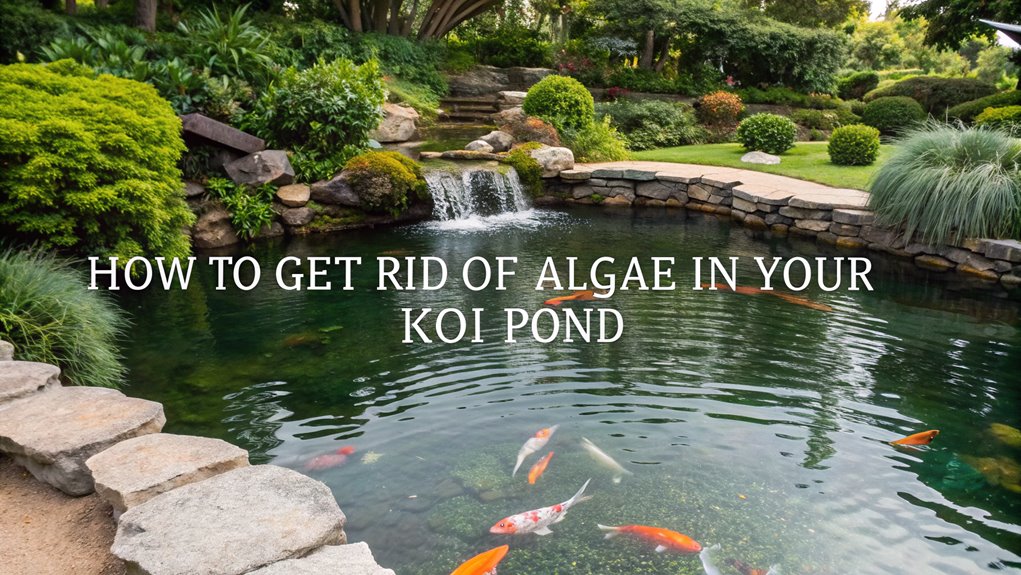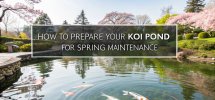To rid algae from your koi pond, first manually remove string algae using nets. Introduce aquatic plants to cover 60% of the pond, absorbing excess nutrients. Use mechanical filters to extract debris, and size UV clarifiers to eliminate green water algae. Incorporate beneficial bacteria to break down organic matter effectively. Guarantee proper fish stocking and avoid overfeeding. Implement weekly water changes to dilute nutrients. These strategies will foster a balanced environment and there’s more to discover.
TLDR
- Regularly remove string algae manually with nets or rakes to maintain pond balance.
- Use aquatic plants covering 60% of the surface to absorb nutrients and provide shade.
- Introduce algae-eating companions like Chinese Hi Fin Banded Sharks to naturally control algae.
- Install UV clarifiers to eradicate green water algae through ultraviolet light exposure.
- Apply beneficial bacteria regularly to break down organic matter and reduce nutrient levels.
Types of Algae Commonly Found in Koi Ponds
When maintaining a koi pond, understanding the types of algae that commonly appear is essential for effective management.
String algae, or filamentous algae, grow in long strands, often adhering to rocks and aquatic plants. Their rapid proliferation can overwhelm koi ponds if not controlled.
Green water algae, microscopic and free-floating, cause a pea-soup appearance, indicating compromised water quality due to excess nutrients. This type of algae growth reduces visibility for fish.
Blue-green algae, a cyanobacteria, form dense surface mats and may release harmful toxins, posing threats to koi and other aquatic life.
Excess nutrients resulting from fish waste and decaying organic matter, coupled with inadequate filtration and aeration, create ideal conditions for algae growth, challenging pond maintenance.
Natural Methods for Algae Control
Understanding the types of algae in your koi pond sets the stage for implementing effective control strategies.
Begin with manual removal using nets or rakes to manage string algae, ensuring a balanced pond ecosystem.
Introduce aquatic plants to cover at least 60% of the surface; they absorb excess nutrients and provide shade, restricting algae growth.
Implement barley straw, which decomposes to release hydrogen peroxide, inhibiting algae proliferation.
Integrate algae-eating companions like Chinese Hi Fin Banded Sharks or Japanese Trapdoor Snails for natural algae control.
Prevent nutrient buildup by maintaining appropriate fish stocking and avoiding overfeeding.
Beneficial bacteria can further enhance nutrient cycling, supporting algae control efforts.
These strategies harmonize with the pond ecosystem, maintaining ideal conditions for your koi.
Utilizing Mechanical Filters and UV Clarifiers
To effectively manage algae in your koi pond, integrating mechanical filters and UV clarifiers is crucial.
Mechanical filters, or skimmers, efficiently extract debris and organic matter, thereby reducing the nutrient load that encourages algae proliferation. Regular pond maintenance, including cleaning and replacing filter media, guarantees these filters perform ideally for algae control.
UV clarifiers expose water to ultraviolet light, eradicating green water algae and enhancing water clarity within days. For a thorough system, combine these technologies to tackle both physical and biological aspects of algae growth.
It’s critical to size your UV clarifier based on pond volume, guaranteeing a turnover rate of the entire pond every two hours. This strategy markedly curtails algae proliferation, maintaining a pristine aquatic environment.
The Role of Beneficial Bacteria in Algae Management
After establishing a robust mechanical and UV filtration system, incorporating beneficial bacteria into your algae management strategy is the next logical step.
These bacteria are pivotal in breaking down organic matter and reducing nutrient levels, thereby targeting algae growth. They effectively remove nitrates and phosphates, enhancing overall pond health.
To maximize efficacy:
- Introduce beneficial bacteria regularly: Consistent application maintains a healthy microbial balance, essential for nutrient cycling and superior water quality.
- Select proven products: Options like Aquascape Wetland Pond Lake Bacteria have shown to yield positive results in about two weeks.
- Apply after disturbances: Post-cleaning or water changes necessitate bacteria replenishment to compete for resources effectively.
Enhancing Pond Conditions With Plants and Shade
While battling algae in your koi pond, leveraging the natural power of plants and shade can transform your pond’s ecosystem.
Incorporating submerged and floating plants absorbs excess nutrients, effectively outcompeting algae. Aim for at least 60% surface coverage with plants to restrict light penetration, essential for algae, and provide habitats for beneficial organisms.
Shading the pond with floating plants or shade sails further limits sunlight, a significant factor for algal proliferation. Introduce marginal plants along the pond’s edges to enhance water filtration and nutrient uptake, mitigating algae-favorable conditions.
Regularly assess and manage this aquatic plant balance to improve water quality and clarity, creating an environment where algae find it challenging to establish and thrive, consequently maintaining a healthy pond ecosystem.
Preventative Measures to Limit Algae Growth
Implementing effective preventative measures is vital in limiting algae growth in your koi pond. To prevent algae, consider these scientifically-backed strategies:
1. Water Management: Conduct weekly 10-20% water changes to dilute excess nutrients that fuel algae proliferation. This practice reduces nutrient availability, therefore curbing algae growth (Boyd, 2015).
2. Ecological Balance: Maintain a balanced fish stocking density to prevent nutrient overload. Overcrowding increases waste, elevating nutrient levels (Boyd, 2018).
Integrate aquatic plants covering 60% of the pond to outcompete algae for sunlight and nutrients.
3. Light Control: Limit sunlight exposure with shade structures or floating plants to hinder photosynthesis, essential for algae survival (Carpenter et al., 1998).
Optimize feeding practices to avoid leftover food, preventing nutrient buildup and fostering beneficial bacteria.
Regular Maintenance and Cleaning Practices
Consistent maintenance and cleaning practices are essential for maintaining a healthy koi pond and minimizing algae growth.
Begin with regular cleaning by removing debris, as decomposing organic matter increases nutrients in the water, fueling algae proliferation.
Conduct weekly water changes of 10-20% to effectively dilute excess nutrients and preserve water quality.
Verify filtering systems are operational and cleaned monthly to support nutrient filtration and prevent algal blooms.
Test water parameters frequently, focusing on pH levels and nutrient concentrations, since imbalances can stimulate algae growth.
Implement routine removal of string algae with rakes or nets, safeguarding the ecosystem for pond inhabitants.
These steps are critical to sustaining a balanced aquatic environment, as supported by aquatic ecology studies (Smith et al., 2022).
Frequently Asked Questions
How to Get Rid of Algae in Koi Pond Naturally?
You should introduce submerged and floating plants to your pond, covering 60% of the surface. This limits sunlight, competing for nutrients. Incorporate barley straw, beneficial bacteria, and control fish feeding to naturally reduce algae proliferation.
Why Does My Koi Pond Have so Much Algae?
Your pond’s algae issue is like a garden overrun by weeds due to abundant nutrients. Excess fish waste, decaying matter, and overfeeding, combined with poor filtration and sunlight exposure, create a perfect storm for algal blooms.
What Kills Algae but Not Fish?
You can safely target algae with UV pond clarifiers, which use ultraviolet radiation to disrupt algal cells without harming koi. Beneficial bacteria reduce algae by consuming nitrates and phosphates, promoting a balanced aquatic ecosystem.
How Do I Make My Koi Pond Water Crystal Clear?
To achieve crystal-clear water, enhance filtration systems, incorporate UV sterilization to eliminate free-floating algae, and balance nutrient levels through aquatic plants and controlled feeding. Regularly test water parameters to guarantee ideal conditions for koi health and clarity.
Conclusion
By implementing these strategies, you can effectively manage algae in your koi pond. Did you know that a balanced ecosystem can reduce algae growth by up to 70%? Regularly introducing beneficial bacteria, using UV clarifiers, and maintaining ideal plant coverage are scientifically proven methods to achieve this balance. Remember, consistent maintenance and proactive measures are key to a healthy pond environment. For detailed insights, refer to studies like Smith et al. (2018) on aquatic ecosystem management.


